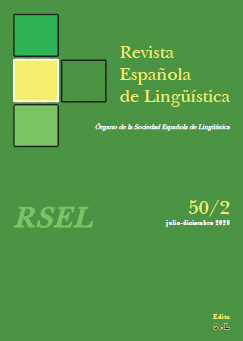Aspect and evidentiality in the Japanese construction v + {-te ~ -de}+ iru
https://dx.doi.org/10.31810/RSEL.50.2.10
Keywords:
Aspectual periphrase; -te iru; evidentiality; mental verbs; sensorial verbs; Japanese language.Abstract
This chapter aims to contribute to the study of the relationship between aspect and evidentiality by examining the grammar and semantics of the <V + {-te ~ -de} + iru> construction in Japanese. Although this construction has been traditionally considered an aspectual one, in recent years a new proposal has emerged that characterizes it as an evidential marker (Sadanobu 2006, Sadanobu and Malchukov 2006, Nagai 2017). Taking into account the growing interest in the relation between aspect and evidentiality, I will review the proposals of the aforementioned authors. Based on this review and adopting the theoretical perspective defended by Speas 2010, I will try to demonstrate that the Japanese <V + {-te ~ -de} + iru> construction can be considered an evidential marker in some specific uses.
Downloads
References
Aoki, H. (1986): «Evidentials in Japanese», en Chafe, W. y Nichols, J. (eds.), Evidentiality: The linguistic coding of epistemology, Nueva York, Ablex Publishing, pp. 223-238.
Arregui, A., Rivero, M. L. y Salanova, A. (2017): «Aspect and tense in evidentials», en Arregui, A., Rivero, M. L. y Salanova, A. (eds.), Modality across syntactic categories, Oxford-Nueva York, Oxford University Press, pp. 211-234.
Bosque, I. (1989): Las categorías gramaticales. Relaciones y diferencias, Madrid, Síntesis.
Bravo, A. (2011): «Las perífrasis de inminencia en español: del aspecto a la modalidad», en Cuartero, J., García Fernández, L. y Sinner, C. (eds.), Estudios sobre perífrasis y aspecto, Múnich, Peniope, pp. 72-98.
Carlson, G. N. (1977): «A unified analysis of the English bare plural», Linguistics and philosophy 1, pp. 413-457.
Chierchia, G. (1995): «Individual-level predicates as inherent generics», en Carlson, G. y Pelletier, J. (eds.), The generic book, Chicago, University of Chicago Press, pp. 176-223.
Chung, K. S. (2007): «Spatial deictic tense and evidentials in Korean», Natural language semantics 15, pp. 187-219.
Escandell Vidal, M. V. (2006): Introducción a la pragmática, 2.ª ed., Barcelona, Ariel.
–, (2018): «Evidential commitment and feature mismatch in Spanish estar constructions», Journal of pragmatics 128, pp. 102-115.
Escobar, A. M. (1997): «Contrastive and innovative uses of the present perfect and the preterite in Spanish in contact with Quechua», Hispania 80, pp. 859-870.
García Fernández, L. (dir.) (2006): Diccionario de perífrasis verbales, Madrid, Gredos.
García Tesoro, A. I. y Jang, J. S. (2018): «El pretérito perfecto compuesto en el español andino peruano: usos innovadores y extensión a contextos de aoristo», Forma y función 31, 1, pp. 93-123.
Gōōda, S. (2013): ‘-teiru’, ‘-te ita’, ‘-te inai’ no asupekuto, Tokio, Kuroshio Publishers.
Grice, H. P. (1975): «Logic and conversation», en Cole, P. y Morgan, J. (eds.), Speech acts (Syntax and semantics 3), Nueva York, Academic Press, pp. 41-58.
Izvorski, I. (1997): «The present perfect as an epistemic modal», Proceedings of semantics and linguistic theory 7, pp. 222-239.
Kalsang, K. y otros (2013): «Direct evidentials, case, tense and aspect in Tibetan: evidence for a general theory of the semantics of evidentials», Natural language and linguistic theory 31, 2, pp. 517-561.
Kindaichi, H. (1950): «Kokugo dooshi-no ichibunrui», Gengokenkyuu 15, pp. 5-26.
Klee, C. y Ocampo, A. M. (1995): «The expression of past reference in Spanish narratives of Spanish-Quechua bilingual speakers», en Silva-Corvalán, C. (ed.), Spanish in four continents: Studies in language contact and bilingualism, Washington D. C., Georgetown University Press, pp. 52-70.
Kratzer, A. (1995): «Stage-level and individual-level predicates», en Carlson, G. N. y Pelletier, F. J. (eds.), The generic book, Chicago y Londres, The University of Chicago Press, pp. 125-175.
Kudōō, M. (1995): Asupekuto-tensu taikei to tekusuto, Tokio, Hitsuji-shoboo.
Nagai, H. (2017): «Nihongo-no ebidenshariti: ‘-te iru’-o jirei-ni», Papers in linguistic science 23, pp. 1-18.
Nikolaeva, I. (1999): «The semantics of Northern Ostyak evidentials», Journal de la Société Finno-Ougienne 88, pp. 131-159.
Okuda, Y. (1978a): «Asupekuto no kenkyuu o megutte I», Kyouiku Kokugo 53, pp. 33-44.
–, (1978b): «Asupekuto no kenkyuu o megutte II», Kyouiku Kokugo 54, pp. 14-27.
Pfänder, S. y Palacios, A. (2013): «Evidencialidad y validación en los pretéritos del español andino peruano», Círculo de lingüística aplicada a la comunicación 54, pp. 65-98.
RAE y ASALE (2009): Nueva gramática de la lengua española, Madrid, Espasa.
Rodríguez Ramalle, T. M. (2013): «Notas para un estudio comparado de la evidencialidad», Revista española de lingüística 43, 1, pp. 171-196.
Sadanobu, T. (2006): «Shin’nai joohoo-no kizoku-to kanri: gendainihonkyootsuugo ‘teiru’-no ebidensharu-na seishitsu-nitsuite», en Nakagawa, M. y Sadanobu, T. (eds.), Gengo-ni arawareru ‘seken’-to ‘sekai’, Tokio, Kuroshio Publishers, pp. 167-192.
Sadanobu, T. y Malchukov, A. (2006): «Ebidenshariti-to gendainihongo-no ‘teiru’koobun», en Nakagawa, M. y Sadanobu, T. (eds.), Gengo-ni arawareru ‘seken’-to ‘sekai’, Tokio, Kuroshio Publishers, pp. 153-166.
Sadanobu, T. y otros (2014): Ninohgogaku-to tsūgengotekikenkyū-tono taiwa: tensu, asupekuto, mūdo kenyū-o tōshite, Tokio, Kuroshio Publishers.
Sener, N. (2011): The semantics and pragmatics of evidentials in turkish, Tesis doctoral, Universidad de Connecticut.
Shirai, Y. (2000): «The semantics of the Japanese -teiru construction: An integrative approach», Journal of pragmatics 32, pp. 327-361.
Slobin, D. I. y Aksu, A. A. (1982): «Tense, aspect and modality in the use of the Turkish evidential», en Hopper, P. (ed.), Tense-aspect: Between semantics & pragmatics, Ámsterdam y Filadelfia, John Benjamins, pp.185-200.
Speas, M. (2010): «Evidentials as generalized functional heads», en Di Scuillo, A. M. y Hill, V. (ed.), Edges, heads, and projections: Interface properties, Ámsterdam y Filadelfia, John Benjamins, pp. 127-150.
Speranza, A. (2014): Evidencialidad en el español americano. La expresión lingüística de la perspectiva del hablante, Madrid y Fráncfort, Iberoamericana-Vervuert.
Squartini, M. (1998): Verbal periphrases in Romance: Aspect, actionality, and grammaticalization, Berlín y Nueva York, Mouton de Gruiyter.
Teramura, M. (1984): Nihongo-no sinutakusu-to imi II, Tokio, Kuroshio publishers.
Vendler, Z. (1957): «Verbs and times», The philosophical review 66, pp.143-160.
Yamaoka, M. (2014): «Bunkinōō-to asupekuto-no sōōkan-o meguru ichikōōsatsu –-te irukei-no ninshōōseigenkaijokinōō-o chūūshin-ni–», Nihongo nihonbungaku 24, pp. 27-40.
Published
How to Cite
Issue
Section
Copyright (c) 2020 Revista Española de Lingüística

This work is licensed under a Creative Commons Attribution-NonCommercial 4.0 International License.











